英汉谚语文化差异及翻译方法
英汉文化差异与汉语谚语的翻译
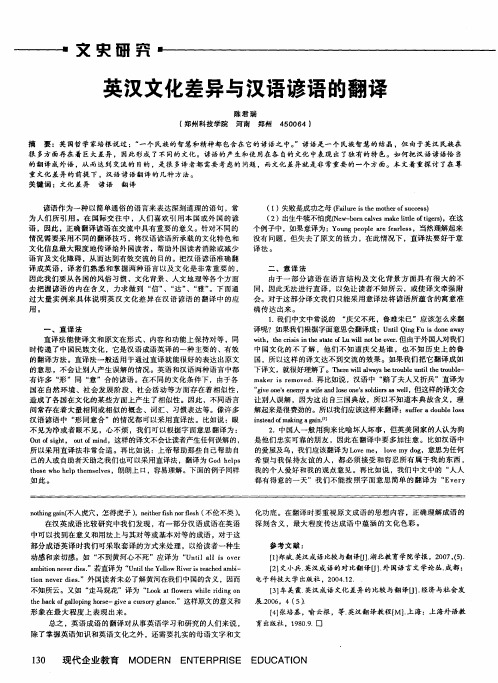
直 译 法
一
、
直译 法 能 使 译 文 和原 文 在形 式 、内容 和 功能 上 保持 对 等 ,同
时传 递 了 中国 民族 文化 ,它 是 汉语 成 语英 译 的一种 主要 的 、有 效 的翻 译方 法 。直译 法 一 般适 用 于 通过 直译 就 能 很好 的表达 出原 文 的意 思 ,不 会 让别 人 产 生误 解 的情 况 。英语 和 汉语 两 种语 言 中都 有 许 多 “ ” 同 “ ”合 的谚 语 。 在不 同 的文 化 条件 下 ,由于各 形 意 国在 自然 环 境 、社 会发 展 阶段 、社 会 活 动等 方 面 存在 着 相 似 性 , 造成 了各 国在 文 化 的某 些 方 面 上产 生 了相 似 性 。因 此 ,不 同语 言 间常 存 在 着大 量 相 同或 相 似 的 概念 、词 汇 、 习惯表 达 等 。像许 多 汉语 谚 语 中 “ 同 意合 ”的情 况 都 可 以采 用 直译 法 。 比如 说 :眼 形 不 见 为净 或 者 眼不 见 ,心 不 烦 。我 们 可 以根 据 字 面意 思 翻译 为 : O t f i t ot f id u g 。 u n ,这样 的译 文不 会让读 者产 生任何误 解 的 , os h om 所 以采 用 直译 法 非 常 合适 。再 比如 说 :上 帝 帮助 那些 自己 帮助 自 己的人 或 白助 者 天助 之我们 也 可 以采用 直译 法 ,翻译 为 G dhls o ep toe h e e sle,朗朗上 1 hs o l t m e s w h ph v 3,容易理解 。下面 的例子 同样
下译文 ,就很好 理解 了o T ee i w y eru l u t e ru l h r wla as obe nit o be ll bt lh t —
策马翻译培训·词句:英汉谚语的文化差异及翻译

英汉谚语的文化差异及翻译[翻译培训·词句]谚语在字典中的定义是短小精练的民间智慧警句,一般形式严谨,经常包括鲜明的形象和使人难忘的韵律。
谚语必须非常睿智,而且经得起时间的考验,才能广为流传。
英汉两种语言历史悠久,包含着大量的谚语,由于地理、历史、宗教信仰、生活习俗等方面的差异,英汉谚语承载着不同的民族文化特色和文化信息,它们与文化传统紧密相连,不可分割。
谚语中的文化因素往往是翻译中的难点。
本文试图借助语用学的理论,对英汉谚语的翻译作一些探索。
1与基督教有关的谚语(Proverbs related to Christianity)宗教是谚语的重要来源之一。
汉语的谚语“平时不烧香,临时抱佛脚”明显与曾在中国广泛流传的佛有关。
包括英语在内的西方家的主要宗教是基督教。
许多英语谚语和基督教有着这样那样的关系是十分自然的。
● Man proposes, God disposes. 谋事在人,成事在天。
● God help those who help themselves. 自助者天助之。
● God sends meat and the devil sends cooks. 上帝赐给食物,魔鬼派来厨师。
● Each cross hath its own inscription. 每个十字架都有自己的铭文。
以上谚语明显与基督教有关,因为谚语里出现的“上帝”或“十字架”都是基督教的象征。
非常有意思的一点是英语中的God 经常与汉语中的“天”相对应。
基督教徒崇拜上帝。
英语中God save the Queen 是家喻户晓的句子。
当一个说英语的人突然从紧张、焦急、或压力下解脱出来的时候,会脱口而出:Thank God!中国人崇拜“天”。
中国古代的皇帝是“天子”,运气好的人是“天之骄子”。
只要好心人得到报答而恶人受到惩罚,我们就会说“苍天有眼”英国人和中国人都要有寻求帮助的对象。
只是说英语的人找的是上帝,而中国人找的是“天”而已。
英汉语谚语文化差异的比较研究
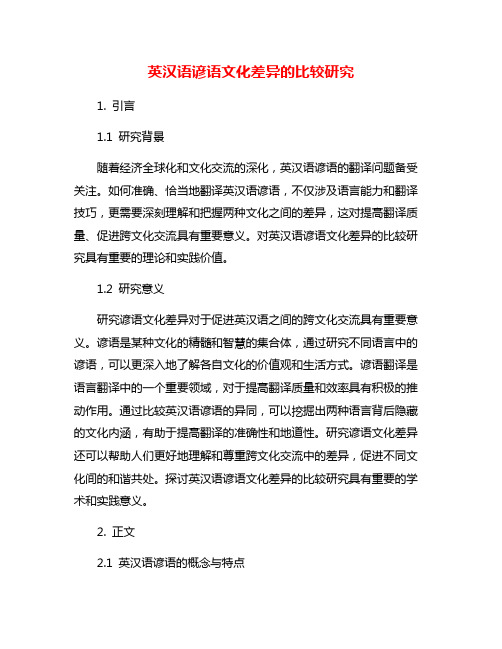
英汉语谚语文化差异的比较研究1. 引言1.1 研究背景随着经济全球化和文化交流的深化,英汉语谚语的翻译问题备受关注。
如何准确、恰当地翻译英汉语谚语,不仅涉及语言能力和翻译技巧,更需要深刻理解和把握两种文化之间的差异,这对提高翻译质量、促进跨文化交流具有重要意义。
对英汉语谚语文化差异的比较研究具有重要的理论和实践价值。
1.2 研究意义研究谚语文化差异对于促进英汉语之间的跨文化交流具有重要意义。
谚语是某种文化的精髓和智慧的集合体,通过研究不同语言中的谚语,可以更深入地了解各自文化的价值观和生活方式。
谚语翻译是语言翻译中的一个重要领域,对于提高翻译质量和效率具有积极的推动作用。
通过比较英汉语谚语的异同,可以挖掘出两种语言背后隐藏的文化内涵,有助于提高翻译的准确性和地道性。
研究谚语文化差异还可以帮助人们更好地理解和尊重跨文化交流中的差异,促进不同文化间的和谐共处。
探讨英汉语谚语文化差异的比较研究具有重要的学术和实践意义。
2. 正文2.1 英汉语谚语的概念与特点英汉语谚语是一种常见的语言表达方式,在英语和汉语中都有着丰富的谚语资源。
谚语是人们在长期生活实践中总结出来的具有智慧和哲理的短小句子,具有较高的文化内涵和智慧。
英汉语谚语在表达形式、文化内涵和使用场景等方面存在一些共同点和区别。
英汉语谚语都是用简练的语言形式表达深刻的哲理和经验。
它们在几个词汇中蕴含着丰富的含义,能够直观地传达人们的思想和观念。
英语谚语"Actions speak louder than words"传达了实际行动比空谈更有力量的道理;而汉语谚语"知己知彼,百战百胜"则强调了了解对手和自己才能取得胜利。
英汉语谚语在文化内涵方面存在一定的差异。
英语谚语多以自然、动物、日常生活等为载体,强调实用性和生活智慧;而汉语谚语则更注重历史、文化、宗教等方面,反映了中国传统文化的思想和价值观。
英语谚语"A rolling stone gathers no moss"比喻不安定的生活方式不利于积累财富和成就;而汉语谚语"塞翁失马,焉知非福"则讲述了一个塞翁因失马而获福的故事,强调了看问题要有全面的思考。
谚语翻译技巧

英汉谚语的区别与翻译原则谚语是通俗简练、生动活泼的韵语或短句,它经常以口语的形式在人民中间广泛地沿用和流传,是人民群众表现实际生活经验或感受的一种“现成话”。
本文主要介绍英汉谚语英汉谚语的特点与区别,并对翻译过程中应掌握的基本技巧作了大致概括。
一、英汉谚语的特征(一)用词精炼、句式整齐经过长期的实践,谚语的用词十分讲究,单句间接凝练、言简意赅,双句大多采用对仗,结构整齐、对称。
汉谚:1、滴水穿石Constant dropping wears the stone2、路遥知马力,日久见人心。
As distance tests a horse's strength.sotime reveals a person's heart.英谚:1、Out of sight,out of mind.眼不见,心不烦。
2、Like father,like son,有其父,必有其子。
(二)音韵和谐、易于上口谚语经过人们长期的使用流传,具有很强的口语化特点,单句讲究韵律,双句讲究对仗,因此说起来朗朗上口,听起来悦耳动听。
汉谚:1、嘴上无毛,说话不牢。
Downy lips make thoughtless slips.2、失之东隅,收之桑隅。
What one loses on the swings one gets back on theroundabouts.英谚:1、Aeeidents will happen in the best-regu-lated families.家规再严,丑事难免。
2、Empty vessels make the most noise.滴瓶不响,半瓶叮当。
(三)比喻生动,寓意深刻谚语来源于生活又反映生活,包含着许多生动形象的比喻,往往蕴含着深刻的人生哲理。
汉谚:1、留得青山在,不怕没柴烧。
As long as green hills remains,there'll never be a shortage of firewood,2、宁为鸡头,毋为牛后。
英汉谚语的文化差异及翻译方法
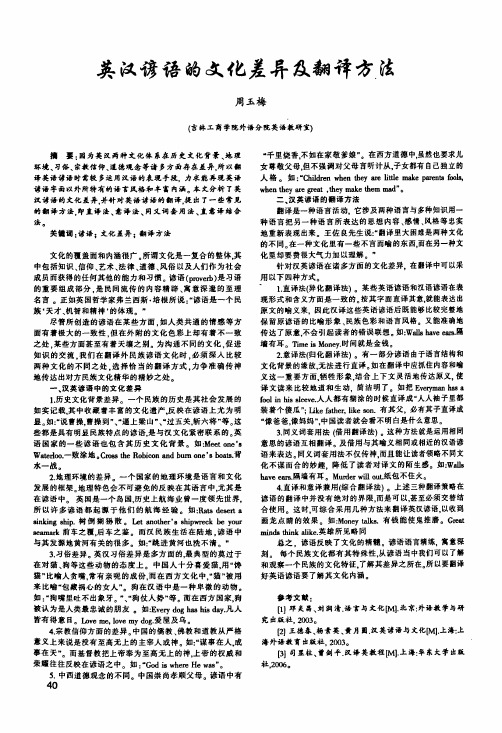
英汉谚语的文化差异及翻译方.法周玉梅(吉林工商学院外语分院英语教研室)摘要:因为英汉两种文化体系在历史文化背景、地理环境、习俗、宗教信仰、道德观念等诸多方面存在差异,所以翻译英语谚语时需较多运用汉语的表现手段.力求能再现英语谚语字面以外所特有的语言风格和丰富内涵。
本文分析了英汉谚语的文化差异.并针对荚语谚语的翻译。
提出了一些常见的翻译方法。
即直译法、意译法、同义词套用法、直意译结合法。
关键词:谚语;文化差异;翻译方法文化的覆盖面和内涵很广。
所谓文化是一复合的整体,其中包括知识、信仰、艺术、法律、道德、风俗以及人们作为社会成员而获得的任何其他的能力和习惯。
谚语(pr o ver b)是习语的重要组成部分。
是民间流传的内容精辟、寓意深邃的至理名言。
正如英国哲学家弗兰西斯.培根所说:“谚语是一个民族‘天才、机智和精神’的体现。
”尽管所创造的谚语在某些方面.如人类共通的情感等方面有着极大的一致性.但在外附的文化色彩上却有着不一致之处。
某些方面甚至有着天壤之别。
为沟通不同的文化,促进知识的交流。
我们在翻译外民族谚语文化时,必须深入比较两种文化的不同之处。
选择恰当的翻译方式。
力争准确传神地传达出对方民族文化精华的精妙之处。
一、汉英谚语中的文化差异1.历史文化背景差异。
一个民族的历史是其社会发展的如实记载,其中收藏着丰富的文化遗产,反映在谚语上尤为明显。
如:“说曹操.曹操到”、“逼上粱山”、。
过五关,斩六将”等。
这些都是具有明显民族特点的谚语,是与汉文化紧密联系的。
英语国家的一些谚语也包含其历史文化背景。
如:M eet one’s W a t e rl oo.一败涂地。
C ross t he R obi con a nd bum one’8boat s.背水一战。
2.地理环境的差异。
一个国家的地理环境是语言和文化发展的框架。
地理特色会不可避免的反映在其语言中。
尤其是在谚语中。
英国是一个岛国,历史上航海业曾一度领先世界,所以许多谚语都起源于他们的航海经验。
英汉俗语差异及汉语谚语的英译
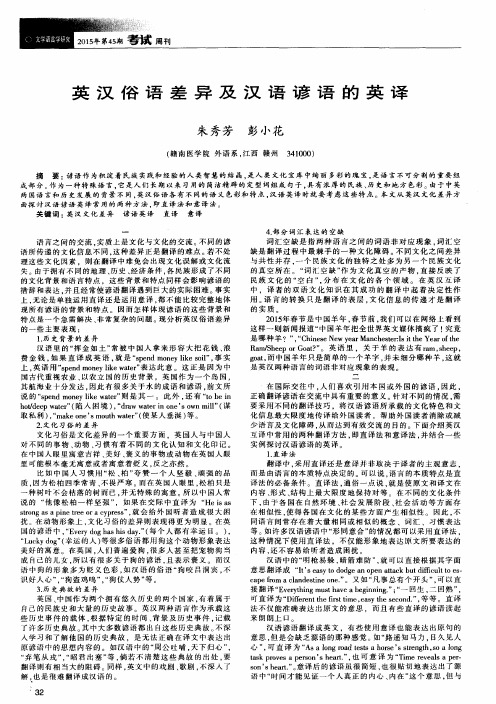
●
英 汉 俗 语 差 异 及 汉 语 谚 语 的 英 译
朱 秀 芳 彭 小花
( 赣南医学院 外语系 , 江西 赣州 3 4 1 0 0 0 )
上, 无论是单独运用直译还是运用意译 , 都 不 能 比较 完 整 地体
现 所 有谚 语 的背 景 和特 点 。 因而 怎样 体 现 谚 语 的这 些 背 景 和 特 点 是一 个 急 需 解 决 、 非常 复 杂 的 问 题 。 现 分 析 英 汉 俗语 差异 的 一 些 主 要表 现 : 1 . 历 史 背景 的差 异 汉语里 的“ 挥金如 土” 常被 中 国 人 拿 来 形 容 大 把 花 钱 、 浪 费金 钱 , 如 果直译 成 英语 , 就是 “ s p e n d mo n e y l i k e s o i l ” , 事 实 上. 英语用” s p e n dmo n e y l i k e w a t e r ” 表 达 此 意 。 这 正 是 因 为 中 国古 代重 视 农业 、 以 农 立 国 的 历 史 背 景 。英 国作 为 一 个 岛 国 , 其 航 海业 十分 发 达 . 因此有很多关于水的成语和谚语 . 前 文 所 说 的“ s p e n d m o n e y l i k e w a t e r ” 则 是 其 一 。此 外 , 还有“ t o b e i n h o f d e e pw a t e r ” ( 陷入 困境 ) , “ d r a ww a t e r i n o n e ’ s o w nm i l l ” ( 谋 取私利) , “ m a k e o n e ’ s mo u t hw a t e r ” ( 使某人垂涎) 等。
英汉谚语中的文化差异研究
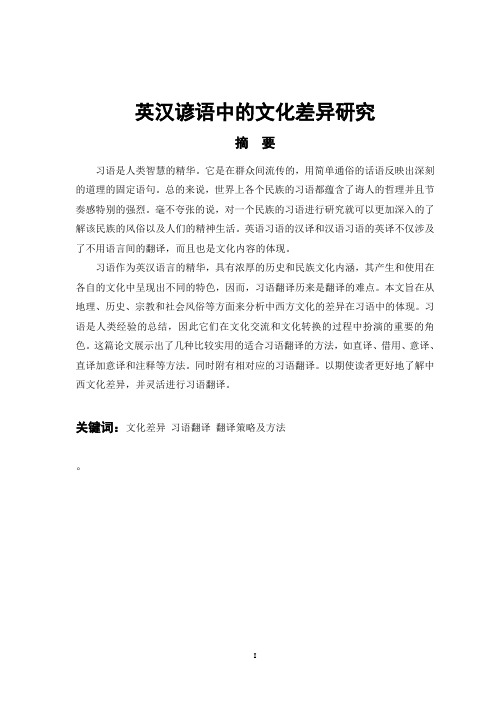
英汉谚语中的文化差异研究摘要习语是人类智慧的精华。
它是在群众间流传的,用简单通俗的话语反映出深刻的道理的固定语句。
总的来说,世界上各个民族的习语都蕴含了诲人的哲理并且节奏感特别的强烈。
毫不夸张的说,对一个民族的习语进行研究就可以更加深入的了解该民族的风俗以及人们的精神生活。
英语习语的汉译和汉语习语的英译不仅涉及了不用语言间的翻译,而且也是文化内容的体现。
习语作为英汉语言的精华,具有浓厚的历史和民族文化内涵,其产生和使用在各自的文化中呈现出不同的特色,因而,习语翻译历来是翻译的难点。
本文旨在从地理、历史、宗教和社会风俗等方面来分析中西方文化的差异在习语中的体现。
习语是人类经验的总结,因此它们在文化交流和文化转换的过程中扮演的重要的角色。
这篇论文展示出了几种比较实用的适合习语翻译的方法,如直译、借用、意译、直译加意译和注释等方法。
同时附有相对应的习语翻译。
以期使读者更好地了解中西文化差异,并灵活进行习语翻译。
关键词:文化差异习语翻译翻译策略及方法。
AbstractProverbs are the most popular language and the embodiment a general truth and the wisdom of a nation. Their meanings are in deep and rhythm. It is not an exaggeration to say that to explore the proverbs of a certain language is one of the feasible approaches to get into the inside of that nation’s people and spiritual life. The English-Chinese and Chinese-English proverb translation involves not only the transfer of language but also the transmission of culture.As the essence of English and Chinese language, proverbs or set phrases have strong historical and cultural contents, whose emergence and use demonstrate different characteristics in its own culture. Therefore, proverb translation has always been the difficulty for translation. The present thesis attempts to study cultural differences between western and eastern proverbs from perspectives like geographic, historical, religious and social customs. Since proverbs are the summary of the common people’s experiences,they play a decisive role in promoting different cultural exchange and cultural transmission.More importantly, this thesis is going to propose several methods for proverbs translation such as metaphrase, borrowing, free translation, metaphrase plus free translation and the use of notes. Practical proverb translation examples and methods are proposed accordingly. It’s hoped that this will benefit learners and readers in their better understanding of cultural differences and skillful translation of proverbs.Key words:cultural differences; proverb translation; translation strategies and methodsTable of Contents摘要 (I)Abstract (II)1 Introduction (1)2 Definition (2)2.1 The definition of proverb (2)2.2 The Definition of cultural dDifferences (2)3. The Analysis of East-West Cultural Differences (3)3.1 Geographic differences (4)3.2 Historical differences (5)3.3 Religious differences (5)3.4 Social customs differences (6)4. Translation Strategies and Methods (7)4.1 Metaphrase (7)4.2 Borrowing (7)4.3 Free Translation (8)4.4 Metaphrase plus free translation (8)4.5 The use of notes (9)5. Conclusion (10)References (11)1 IntroductionLanguage is the carrier of culture, which reflects the culture it represents. Set phrase or proverb is an indispensable essence part of culture, which contains very rich historical, social, religious and cultural contents. Actually, proverbs are seen as the most important too for people’s communication which can be treated as an indispensable part of culture and is influenced by culture in return. Without culture, language would be insignificant. Moreover, proverbs are considered to be the most popular saying in the society and the wisdoms of a nation which reveals the people’s mind and wisdom in pieces of words. Without proverbs, language would lack spirit and color. A concentrated reflection of various rhetorical means and a mirror of the historical and cultural conceptions of a society are revealed in proverbs.Proverbs between eastern and western countries vary differently due to their different ways of living, ways of thinking, different historical development and different cultures. Therefore, proverb translation has always been the difficulty for translation. Nevertheless, the successful translation of proverbs is of vital importance in inter-lingual and inter-cultural communication between China and western countries, and east-west cultural differences are among the largest barriers of proverb translation. It is thus very important and necessary for us to probe into the west-east cultural differences and come up with practical proverb translation strategies and methods in order to help learners and readers better understand the cultural differences and better translate proverbs.The present thesis attempts to study cultural differences between western and eastern proverbs from perspectives like geographic, historical, religious and social customs. Since proverbs are the summary of the common people’s experiences,they play a decisive role in promoting different cultural exchange and cultural transmission.More importantly, this thesis is going to propose several methods for proverbs translation such as metaphrase, borrowing, free translation, metaphrase plus free translation and the use of notes.2. Definition2.1 The definition of proverbProverb or set phrase is the crystal of language accumulated and extracted during people’s long-time practice and use. Proverbs often come from ancient classics, famous masterpieces, historical stories and folktales, which contain rich cultural information and have strong national characteristics. Proverb has the characteristics of vividness, profoundness, conciseness, humor and meaningfulness. Even within a single language community, proverb, and the extent to which it is used, tends to vary widely across social, ethnic, economic, and geographic strata. Proverb may fall into disuse over time; sometimes, however, it grows more and more common until it becomes the dominant way of saying something, at which time it usually comes to be regarded as mainstream, acceptable language, although in the case of taboo words there may not be an expression which is considered mainstream or acceptable. Numerous proverb terms pass into informal mainstream speech, and sometimes into formal speech, though this may involve a change in meaning or usage.Proverb often involves the creation of new meanings for existing words. It is common for such novel meanings to diverge significantly from the standard meaning.A proverb is a simple and concrete saying, popularly known and repeated, that expresses a truth based on common sense or the practical experience of humanity. They are often metaphorical. A proverb that describes a basic rule of conduct may also be known as a maxim.Proverbs are often borrowed from similar languages and cultures, and sometimes come down to the present through more than one language. Both the Bible and Medieval Latin have played a considerable role in distributing proverbs across Europe, although almost every culture has examples of its own.2.2 The definition of cultural differencesThere are different meanings to the word “culture”. Sometimes, people who know about music, art, literature are thought to be cultured. However, to an anthropologist, the word “culture” means all the ways that a group of people think, feel, eat and dress. TheLongman Dictionary of Contemporary English gives such an explanation of culture: the customs, beliefs, art, music, and all the other products of human thought made by a particular group of people at a particular time. The linguistic difference that informs any cultural performance is dramatized in the common semiotic account of the disjuncture between the subject of a proposition and the subject of enunciation, which is not represented in the statement but which is the acknowledgment of its discursive and address, its cultural, its reference to a present time and a specific space. The pact of interpretation is never simply an act of communication between the I and the you designated in the statement. The production of meaning requires that these two places be mobilized in the passage through a Third Space, which represents both the general conditions of language and the specific implication of the utterance in a performative and institutional strategy of which it cannot “in itself” be conscious. What this unconscious relation introduces is ambivalence in the act of interpretation According to the famous translator Eugene Nida, culture is “the totality of beliefs and practices of a society”. He also holds that “Nothing is of greater strategic importance than the language through which its beliefs are expressed and transmitted and by which most interaction of its members take place.”Therefore it is obvious that cultural differences mean the differences in histories, religions, cultures, social beliefs and customs, etc. For instance, when people die, different cultures deal with their bodies differently. Sometimes bodies are burned; sometimes bodies are buried under the ground. In many cultures in the past, people were buried with food, weapons, and other things that might be useful in the next life. For example, the ancient Egyptians buried people with little human figures which were from clay. These clay figures were intended to work the death person in the other world.From above, we can see that cultures vary differently from one culture to another. There are many factors underlying in cultural differences, the author of this paper will conduct further analysis later in the following.3. The Analysis of East-West Cultural DifferencesThere are a number of cultural differences between China and other westerncountries, but the differences can be overcome in inter-cultural communications. Having a good command of the factors about the differences would help people better understand the language and the culture, so to perform successful communications. This paper has mainly chosen four east-west cultural differences: geographic differences, historical differences, religious differences and social customs differences. In the following, this paper will further discuss the main four differences respectively.3.1 Geographic differencesPeople in different countries live in different geographic environments, thus different cultures and different proverbs were formed in the process of laboring and struggling with nature. A certain culture exists in a certain terrain; inevitably, it reflects the natural and geographic features of the area. For this reason, when people use natural sights or objects to express themselves, there would be obvious differences. What’s more, people in different cultures hold different attitudes towards different natural phenomenon relevant to their living conditions, so the expressions of proverbs are also quite different.For example, China has long been an agricultural country with a vast land, so it has many expressions or proverbs with land or agriculture, such as “七十二行,庄稼人头一行”, “百叶农为本,民以食为天”, “地不翻,苗不欢”, “种田不用问,用好水和粪” and so on. However, Britain is an island country surrounded by vast sea, so it has many expressions or proverbs related to boats or seas, such as “The best fish swim near the bottom” (好鱼沉水底), “to go with the stream” (随波逐流), “The good seaman is known in bad weather”(要识还海员,须凭坏天气), “There’s as good fish in the sea as ever come out of it” (有了大海,害怕没鱼), “A man may lead a horse to the water, but he can’t make him drink” (牛不喝水,按不低头) and so on. These kinds of examples are numerous. Also, there are many proverbs peculiar to specific geographic areas, for instance, in English “bring coal to Newcastle”(多此一举), since Newcastle is a place abundant in coal. Meanwhile, there are similar proverbs in Chinese, such as “边收边耕,叶草不生”, “好树结好桃,好种出好苗”, “春风不刮,春芽不发” and so on.The totally different geographical differences of the east and west are responsible for the different cultural values embodied in the proverbs of the two languages.3.2 Historical differencesApart from geographic differences, historical differences are also of great importance. A certain culture is formed through a nation’s history, so when discussing cultural differences, historical differences cannot be neglected. Different countries have different historical developments, stories, legends, allusions and so on. For example, throughout the history, Chinese people define themselves as the descendents of “Yandi and Huangdi Emperors” the “Dragon” and the “Cathay”; so an proverb was “炎黄子孙”. There are also proverbs relevant to wars, persons, etc. such as “唱空城计”, “败走麦城”, “东施效颦”, “名落孙山” and so on. In English, there are also proverbs or expressions related to wars, persons peculiar in its own culture, such as “to meet one’s Waterloo” to mean failure, “a Trojan horse” to mean potential dangers, “Achilles’ heel” to mean one’s fatal weakness, the week or vulnerable point of a person, an organization, a country and “Pandora’s box” to mean the root of evils. There are boundless examples like this. The historic value of a certain culture is unique; people should pay special attention to it when engaged in inter-cultural communication and proverb translation.In brief, both East and West have its own historic field and literary works to reflect their proverbs. Only if the translator translates proverbs well, can the exact meaning will be transmitted.3.3 Religious differencesReligious belief is one aspect of human thought, which has great influence on culture. In many western countries, particularly in English-speaking countries, people believe in Christianity. They believe that God is all mighty. So there are many proverbs related to their belief. For example, “A tree is known by its fruit” (观果实可知树,观其行可知人), “God help those who help themselves”(自助者天助). In addition, the Bible has greatly affected the western culture, and some proverbs are derived from Bible, such as “the forbidden fruit” (禁果), “as poor as Job” (一贫如洗), “eye for eye and teeth for teeth” (以眼还眼,以牙还牙), and so on. While Chinese culture, on the other hand, was mainly influenced by Confucianism, Taoism and Buddhism. Proverbs like “平时不烧香,临时抱佛脚”“泥菩萨过河,自身难保” reflect Buddhism; “乐极生悲”“脱胎换骨”“回光返照” are derived from Taoism; while “平安是福” is from Confucianism. Religion is a complex factor in inter-cultural activities, thus it cannot be ignored for its profound influence on cultures.From the analysis proverbs above, we can infer that God is powerful in Christianity and Buddha is mighty in Buddhism. The Chinese people adore the Buddha and the westerners show respect to the God.3.4 Social customs differencesSocial customs also play an important role in east-west cultural differences, as it embodies a nation’s history and value. Countries with different social customs have different beliefs, values and different national emotions. Just take China and English-speaking countries as an example, in China, horse is regarded as loyal and patient, so Chinese people treat horses as friends. There are many favorable proverbs related to horses, such as “马到成功”, “马首是瞻”. While Westerners regarded horses as their companion in their life as they can reveal from the proverbs like “a horse stumbles that has four legs”(everyone will make mistakes in one day), “it is too late to lock the stable door after the horse has bolted”(one needs to make preparation in advance, otherwise, he will suffer incurable loss).Dog is a low-down animal in Chinese culture, so proverbs related to dogs are derogatory, such as “狗嘴里吐不出象牙”, “狗咬耗子,多管闲事”,“狗咬吕洞宾,不识好人心”etc. On the contrary, English people regard dogs as faithful friends, so English proverbs relevant to dogs are positive. For instance, when they say someone is lucky, they would say “a lucky dog”; however, proverbs related to horses are not always good, such as “pay for a dead horse” means waste money.For another example, Chinese and English people hold different attitudes towards “dragon”. Chinese people think dragon as auspicious and precious, thus proverbs related to dragon are always predatory, such as “望子成龙”, “龙凤呈祥”and “乘龙快婿”. While western people often regard dragon as evil and ferocious, thus proverbs related to dragon are always negative, such as “chase the dragon” means taking drugs.Social customs have much to do with the national characteristic of proverbs. From the analysis above, we may find that people’s different attitudes towards the sameanimals are quite different, as the horse and the dog.4. Translation Strategies and MethodsFrom above analysis, we have already known the four main cultural differences between proverbs of China and western countries. In this chapter, the author will come up with some strategies and methods for proverbs translation. We summarized five main translation strategies and methods, namely: metaphrase, borrowing, free translation, the method of metaphrase combined with free translation and use of notes, in the hope to help learners and readers better translate proverbs, thus to ensure excellent translation texts and successful communications.4.1 MetaphraseMetaphrase is a method to translate Chinese proverbs directly into English. It is able to keep the meaning, form, and grammatical structure of the source language when adopting this method. Nevertheless, the method of metaphrase doesn’t mean translate the source proverbs word by word. For example, the Chinese proverb “三人行,必有我师”can be divided into two parts: “三人行” and “必有我师”. Their counterparts in English are “three men” and “teach”, so when translating “三人行,必有我师”, translators can adopt the method of metaphrase to translate it like “When there are three men walking together, one of them is bound to be able to teach me something”. For another examples, “路遥知马力,日久见人心” (A long road test a horse ‘s strength and a long talks proves a man’s heart), “井干方知水可贵”(We never know the worth of water till the well is dry), “吠犬不咬人” (Barking dogs do not bite) and so on.When using metaphrase method, the translator should follow several rules. The first is that the translation should transfer the message from the source text completely. The second is that the translation should accord with the characteristics of the target language. The last but not the least, the translation shouldn’t evoke incorrect imagination to readers.4.2 BorrowingBoth Chinese and English have lots of similar proverbs. Some Chinese and English proverbs have similar meanings and forms. Therefore, translators can use the method of borrowing when translating proverbs. For example, some Chinese proverbs and Englishproverbs have similar or underlying meaning, and they also have similar image or metaphor, such as the Chinese proverb “吃一堑,长一智” and the English proverb “A fall into the pit, a gain into your wit” have the same underlying meaning. The proverb “隔墙有耳,窗外岂能无人”and its translation “Wall have ears, and outside the window is there not a man?”Not only have the same metaphor meaning, but also have similar image. Some Chinese proverbs and English proverbs do not have the same image, but they do have the same metaphor meaning. For example, “山穷水尽” in Chinese means a hopeless situation. The English proverb “at the end of one’s rope” also means somebody has done all they could but still couldn’t find a way to solve the problem. Thus “at the end of one’s rope”is a preferred translation for “山穷水尽”. Using the method of borrowing, the target readers would have a sense of familiarity, which makes it easier for them to understand the translation and the culture.4.3 Free translationFree translation is the method mostly adopted when translators cannot translate the proverbs literally. For example, if translators use the method of metaphrase when translating the Chinese proverb “开门见山”, the translation would be “to open the door and see the mountain”, which is very awkward. In order to translate the original message more precisely, free translation should be adopted, since it focuses more on meaning. Then the proverb “开门见山” can be translated into “to come straight to the point”. The Chinese proverb “完璧归赵”has a metaphor meaning, which means give something back without a tiny damage. If we directly translate the proverb like “return the jade intact to the state of Zhao.”, then the metaphor meaning is lost. It’d better be translated as “return something to its owner in perfect”. There are also numerous other examples, such as “refuse to be convinced until faced with grim reality” (不见棺材不落泪), “stay out of things that don’t concern you” (井水不犯河水), “more hands, less work done” (一个和尚挑水吃,两个和尚抬水吃,三个和尚没水吃), “吹毛求疵” ( to pick a hole in one’s coat), “生灵涂炭” (to plunge the people into misery and suffering), and so on.4.4 Metaphrase plus free translationThere exist cases that either metaphrase or free translation can express the meaningof the source proverbs properly. At this moment, the translator could combine the method of metaphrase with free translation. For instance, the Chinese proverb “垂涎三尺”, “垂涎” can be directly translated like “mouth waters”, but “三尺” cannot be translated just as “three feet”. Or else, readers would be confused with the numbers. For this reason, translators can metaphrase the first part and freely translate the second part. The translation for “垂涎三尺” is “The mouth waters copiously”. For another example, “怨声载道” in Chinese, “怨声”can be directly transferred as “complaints”or “discontents”, but “载道”cannot be metaphrased as “fill the road”. Actually, “载道”can be freely translated as “everywhere”. Thus this proverb can be translated like “Complaints are heard everywhere”. Also, the proverb “走马观花” can be translated into “look at flowers while riding on the back of a galloping horse—give a cursory glance.”By combining these two methods, we can on the one hand maintain certain form or image of the source text, and on the other hand maintain the meaning.4.5 The use of notesThe last method of proverb translation in this paper is the use of notes. Strictly speaking, the use of notes can’t be deemed as a method of translation; however, how well translators deal with it determines the quality of the translation. Most Chinese and English proverbs that need to use notes in translating are derived from myths, allusions or historical stories, which have strong historical and cultural background. For example, “叶公好龙” can be translated as “Lord Sheh’s love of dragons” (Note: Lord Sheh was so fond of dragons that he adorned his whole palace with drawings and carvings of them. But when a real dragon heard of his infatuation and paid him a visit, he was frightened out of his wits). For another instance, “东施效颦”, “东施” was an ugly girl, and “颦” refers to Xishi—one of the four most beautiful girls in ancient China. This proverb contains a historical story. Dongshi wanted to be a beautiful girl just like Xishi, so she imitated Xishi. When translating this proverb, translators should use notes for explanations of readers. However, in most cases, notes are long. So it is recommended to use notes only when necessary.In this part, the paper has mainly discussed five common and different strategies andmethods of proverbs translation. Each strategy should be employed in suitable situation in an appropriate manner.5. ConclusionThis paper makes an attempt to analyze the cultural differences between Chinese and English proverbs, as well as translation strategies and methods; which aims to figure out the influences cultural differences have on proverbs translation, and comes up with some practical translation strategies and methods of proverbs. It is hoped that this paper will provide some enlightenments and suggestions for learners and readers. Owing to the cultural differences, it is difficult for translators to find the best method in proverb translation. All the four methods in the thesis are not the ideal or correct solutions and there may exist some better methods to be found. After all, they may treat as a reference for translators. Furthermore, the study of Chinese proverbs and the appropriate translation methods are helpful to promote the cultural exchange between English and Chinese.In order to promote interaction among different cultures and to ensure successful communications, special attention should be paid to proverb translation since it is an indispensable part of a language which contains rich cultural information. When translating proverbs, translators should know well of the foreign histories and customs, master a lot of similar foreign proverbs or expressions, have a good command of the source language and be flexible and skillful in the use of proverb translation strategies and methods. Only in this way can translators render better translation whether in form or meaning or both.Finally, it should be acknowledged that what has been done in this thesis may not be a final solution to the problem. Rather, it is hoped to be helpful for the translation of Chinese and English proverbs and provide some information for further relevant researches.正文字数要4000字左右,你的严重不足。
英汉成语谚语中的语言文化差异

切忌“望文生义” ,“生搬硬套”
文化差异与翻译
文化不可译现象
不同的语言文化之间存在着巨大的差异。 一个民族的语言学承载另一个民族的文化, 必然造成许多难以处理的翻译问题,即文 化不可译现象。
e.g. 妯娌,连襟
Women who are married to brothers; men who are married to sisters. e.g. 她们是妯娌
spend money like water. 挥金如土
英国是, 岛国,航海业曾一度领先世界;
汉民族是农耕民族。人们的生活离不开土 地。
英语中有许多关于船和水的习语,在汉语中 没有完全相同的对应习语,如;to rest on one’s oars (暂时歇一歇).to keep one’s head above water (奋力图存)。all at sea (不知所措) 等等。
大海捞针look for a needle in a haystack. 班门弄斧teach fish to swim. 三个臭皮匠,顶个诸葛亮Two heads are better than one. 妻管严henpecked husband 诸葛亮(的形象)“He is as wise as Solomon” 洗心革面 To turn over a new leaf 山中无老虎,猴子称霸王Among the blind the oneeyed man is king.
见风使舵 See which way the cat jumps 倾盆大雨 It rains cats and dogs. 一贫如洗 (穷光蛋)Poor like a church mouse. 度日如年 donkey years 班门弄斧 Never offer to teach fish to swim. 三伏天 dog days
从英汉谚语中看中西文化差异

关 丽 芳
( 泉州 市 农 业 学 校 , 建 泉 州 3 2 0 ) 福 6 0 0 摘 要 : 语 是 从 人 民 口语 和 经 典 著 作 中提 炼 出 来 的 语 谚 言精 华 . 于 中西 方 的 社会 文化 存 在 着很 大 的 差的 “ 语 ” 词 与 英 语 中 的 “ rv r ” 体 一 致 . 谚 一 po eb 大 在 《 代 汉 语 词 典 》 修 订 本 ) , “ 语 ” 义 为 : 群 众 中 间流 现 ( 中 将 谚 定 在 传 的 固 定词 句 , 简 单 通 俗 的 话 反 映 m 深刻 的道 理 。“ rv r ” 用 po eb 在 《 文 当 代 英 语 词 典 》 英 语 版 ) 的 定 义 为 : h r w l 朗 ( 中 a sot el —
k o ae n a o tis d iea o ti e ea。学 习作 n wns tme th t nan vc b u f i g n rl t t c a le n 为 人 类 语 言 和 思 想 浓 缩 的 结 晶 的谚 语 ,有 助 于 深 刻 理 解 西 方
文化 , 以及 作 为 文 化 载 体 的 语 言 。 2 英 汉 谚语 所体 现 出 的 文 化 差 异 . 谚 语 . 为 人 类 文 化 生 活 的 文 明 成 果 , 映 着 各 自 民族 的 作 反 文 化 、 活 习 俗 和 道 德 取 舍 。 由 于 不 同 民 族 生 活 的地 理 环 境 、 生
“
自然 气 候 、 教 习俗 等 诸 多 方 面 的不 同 , 创 造 的谚 语 在 某 些 宗 所 方面所体现的文化色彩有着很大的地方差异。 2 1 历 史典 故 有 关 的谚 语 .与 在 英 汉 两 种 语 言 中有 大量 由 历 史 典 故 形 成 的谚 语 。 在 中 国 的典 籍 中 , 语 多 出 自诗 书 、 子 论 著 , :千 丈 之 堤 , 于 谚 诸 如 “ 溃 蚁穴。—— 《 非子 ・ 老》“ ” 韩 喻 ; 以貌 取 人 , 之 子 羽 。 《 记 ・ 失 ”史 仲 尼 弟 子 列 传 》 “ 为 玉 碎 ,不 为 瓦全 。 ” ;宁 —— 《 齐 书 ・ 景 安 北 元 传 》 “ 积 跬 步 , 以 至 千 里 。” — 《 子 ・ ;不 无 — 苟 劝学 》这 些 谚 语 结 ; 构 简单 , 义 深 远 , 有教 育 和 警示 作用 。 意 很 而 英 语 中 的 典 故 多 来 自《 经 》 古 希 腊 罗 马 神 话 等 两方 圣 、 经 典 著 作 , 据 《 经 》 载 , d m是 人 类 的 始 祖 , 最 古 老 的 根 圣 记 Aa 即 人 , 以a l a A a 所 s d s d m就 是 “ 常 古 老 , 常 陈 旧 ” 意 思 。再 o 非 非 的 比 如 : ra O t d nmyt g e ( 头 壮 牛 站 在 我 的 舌 头 A ge t Xs n s n u . 一 a o o 上 。 “ 牛 ” 表 不 可 挪 动 的 重 物 。 句 的意 思 是 : 话 极 其 谨 )壮 代 全 说 慎 与汉 语 “ i缄 其 口” 近 相 22 地 理 有 关 的 谚 语 .与 每 个 民族 都 在 一 定 的 自然 环 境 中 生 存 繁 衍 ,因 而 不 同 民 族 的一 些 谚 语 的产 生 和 该 民族 的 自然 环 境 、 理 环 境 、 地 山川 物 i h le指 “ 怏 不 乐 或 心 情 沮 丧 ” 本 来 心 情 ( o ) 无 色 nte u s 怏 b . mo d 是 彩 而 言 的 、 个 短 语 的 隐 喻 意 即 由始 源 域 “ l ” 起 令 人 沮 丧 这 bu 引 e 的色 彩 投 射 到 目标 域 “ 的 心 情 ” 产 生 的 。 如 , le a s 指 人 上 另 bu w , l 严 格 的法 律 , 指 周 日禁 止 跳 舞 宴会 等 , 于 美 国 殖 民 地 时 期 尤 始 清 教 徒 颁 行 的法 律 。 6绿 色 (re . ge n) 绿 色 是 生命 的颜 色 , 人 想起 春天 、 叶 、 地 等 , 青 春 、 使 树 草 有 活 泼 、 活 力 的隐 喻 。 英 汉 两 种 语 言 文化 中 , 色都 可 象 征 安 有 在 绿 全 和 平 , .re v lt n ge np ae 如 ge nr o i ,re e c 。但 绿 在 汉语 言 中还 有 e uo 独 特 的 隐 喻 . , 戴 绿 帽子 ” 指 某 人 的 妻 子 与 他 人 私 通 , 果 如 “ , 如 直 译 成t w a a r e a.西 方 人 估 计 就 理 解 为 有 人 戴 着 绿 色 o er e n t g h 的帽 子 , 能 理 解 它 隐 含 的 意义 , 翻译 成 “ ea u k l ” 不 应 t b c c od 。 o 人 们 使 用 颜 色 词 进 行 隐 喻 认 知 是 人 类 对 颜 色 认 识 发 展 的 高级 阶 段 . 色 词 的 联 想 意 义 是 一 种 思 维 活 动 和 文 化 价 值 颜 的体现 , 因此 英 汉 语 文 化 中颜 色 词 的联 想 意 和各 自文 化 模 型 密 切 相 关 。 文 对 两 种 语 言 文 化 中基 本 颜 色 词 的 隐 喻 意 义 进 本 行 了对 比 . 现 基 本 颜 色 词 的 一 些 隐 喻 在 两 种 文 化 中 有 相 似 发 之 处 , 受 各 自文 化 价 值 、 统 习 俗 、 仰 等 因 素 的 影 响 , 但 传 信 基 本 颜 色 词 的 隐 喻 认 知 呈 现 了 不 同 的个 性 与 差 异 , 管 同 中 有 尽 异 , 用 基 本 颜 色 词 进 行 隐 喻 认 知 时 , 们 对 世 界 的 认 识 更 但 我 加真实 和生动 了, 而使英 汉两种语 言文化更加 丰富 了。 从 参考文献 : [ ] 惠 南 . 化 语 境 与 语 言 翻 译 [ . 京 : 国 对 外 翻 1包 文 M] 北 中 译 出版 公 司 .0 1 20. [ ] 惠 南 , 昂. 国 文 化 与 汉 英 翻 译 [ . 京 : 文 出 2包 包 中 C] 北 外
英汉习语的文化差异和翻译

英汉习语的文化差异及其翻译中文摘要同一句话,不同的文化背景的人反应有时是不同的,甚至会截然相反。
究其原因是说话双方没有真正了解对方的文化。
因此,完全有必要对中西文化差异进行研究。
习语是各国文化的精髓,反映各国的风俗习惯。
它作为语言的精华承载着丰富的文化信息,充分反映出英汉两种语言的文化差异。
因此,本文从最能体现中西文化差异的习语着手,论述习语在文化上六个方面中所反映的中西文化差异,即生存环境、生活习俗、宗教信仰、历史典故、对客观事物的认识、数字习语的差异。
从总体上看,英汉习语在表现语义和文化特征方面,主要有三种类型,即对应关系、半对应关系和不对应关系。
在翻译时,对应关系的习语可采用直译的方法。
半对应关系和不对应关系的习语应该首先弄清它们的文化内涵和实际意义,再根据上下文的意思灵活处理。
因此,英汉习语的翻译不应只是两种语言的简单转换,更应是文化的交流。
掌握习语的翻译,对于培养语言的领悟力和跨文化的交际能力是十分必要的。
关键词:习语;文化差异;翻译AbstractDifferent people from different cultures may have different understandings of the same sentence because they are ignorant of target cultures. It is necessary for us to study the cultural differences in some fields between China and Western countries. Idioms, which reflect customs, are the essence of culture in every country. Idiomatic phrases, the essence of languages, are loaded with rich cultural information and serve as a mirror of cultural differences between Chinese and English. Therefore, in this paper, the author will discuss the idioms reflecting the differences of Chinese and English in six levels: living environment, custom, religion, allusion, the acknowledge of objective thing. When expressing linguistic meanings and cultural features, there are mainly three types of idioms: correspondent, semi-correspondent and non-correspondent. For the correspondent idioms, we can translate them word for word into the target language .But for the semi-correspondent and non-correspondent idioms, it’s better to make sure first of their cultural connotat ions and practical meanings, and then translate them appropriately according to the context. Therefore, translation of idiomatic phrases is more cultural communication than simple translation of these two languages. The mastery of the technique for translating idiomatic phrases is a must to the cultivation of linguistic comprehension and intercultural competence.Key words: idioms; cultural differences; translation语言承载着丰富的文化内涵,而作为语言精华的习语更是如此。
英汉谚语文化对比与翻译
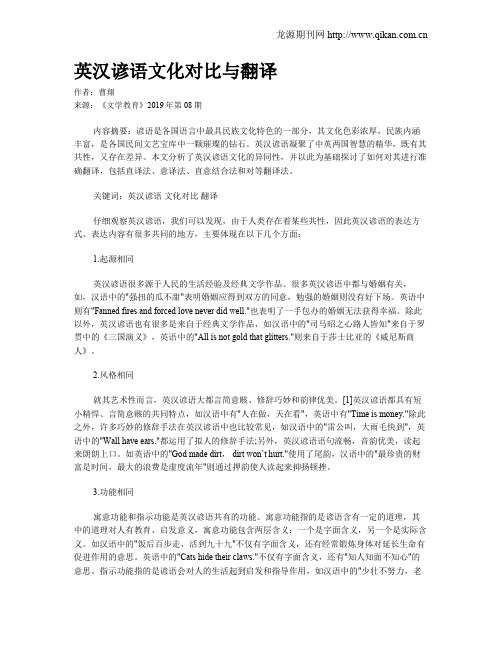
英汉谚语文化对比与翻译作者:曹翔来源:《文学教育》2019年第08期内容摘要:谚语是各国语言中最具民族文化特色的一部分,其文化色彩浓厚,民族内涵丰富,是各国民间文艺宝库中一颗璀璨的钻石。
英汉谚语凝聚了中英两国智慧的精华,既有其共性,又存在差异。
本文分析了英汉谚语文化的异同性,并以此为基础探讨了如何对其进行准确翻译,包括直译法、意译法、直意结合法和对等翻译法。
关键词:英汉谚语文化对比翻译仔细观察英汉谚语,我们可以发现,由于人类存在着某些共性,因此英汉谚语的表达方式、表达内容有很多共同的地方,主要体现在以下几个方面:1.起源相同英汉谚语很多源于人民的生活经验及经典文学作品。
很多英汉谚语中都与婚姻有关,如,汉语中的"强扭的瓜不甜"表明婚姻应得到双方的同意,勉强的婚姻则没有好下场。
英语中则有"Fanned fires and forced love never did well."也表明了一手包办的婚姻无法获得幸福。
除此以外,英汉谚语也有很多是来自于经典文学作品,如汉语中的"司马昭之心路人皆知"来自于罗贯中的《三国演义》,英语中的"All is not gold that glitters."则来自于莎士比亚的《威尼斯商人》。
2.风格相同就其艺术性而言,英汉谚语大都言简意赅、修辞巧妙和韵律优美。
[1]英汉谚语都具有短小精悍、言简意赅的共同特点,如汉语中有"人在做,天在看",英语中有"Time is money."除此之外,许多巧妙的修辞手法在英汉谚语中也比较常见,如汉语中的"雷公叫,大雨毛快到",英语中的"Wall have ears."都运用了拟人的修辞手法;另外,英汉谚语语句流畅,音韵优美,读起来朗朗上口。
如英语中的"God made dirt,dirt won’t hurt."使用了尾韵,汉语中的"最珍贵的财富是时间,最大的浪费是虚度流年"则通过押韵使人读起来抑扬顿挫。
英汉谚语翻译中文化差异的处理--异化与归化
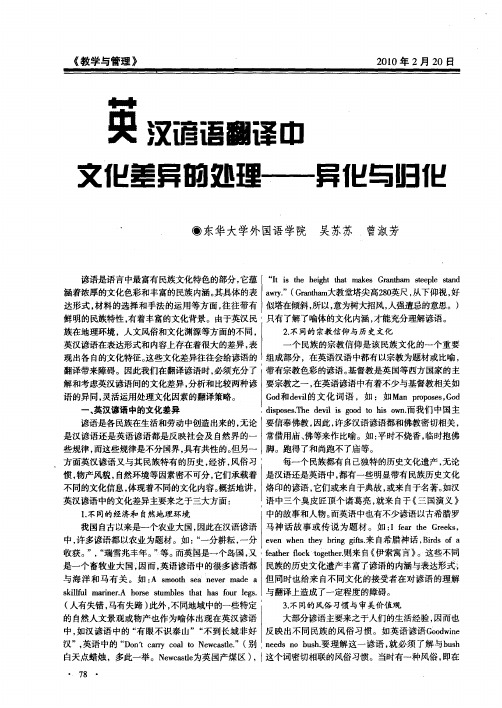
翻译带来障碍。因此我们在翻译谚语时 , 必须充分了 l 带有宗教色彩的谚语 。 基督教是英 国等西方 国家 的主
解和考虑英汉谚语间的文化差异 , 分析和比较两种谚 I 要宗教之一 , 在英语谚语 中有着不少与基督教相关如 语的异同, 灵活运用处理文化因素的翻译策略。
一
、
英汉谚语中的文化差异
《 教学与管理 》
21年 2 2 00 月 0日
.一.
央 汉 语 译l 谚 翻 【 】
文化差 异硇处理 异化与 归化
⑩东华大学外 国语 学院 吴苏苏 曾淑芳
谚语是语言中最 富有 民族文化特色的部分 , 它蕴 『 I i be hi a m ks Gab m s el s n t s e “ stb t ae r a t pe t d n e a a r. Gm ̄a wy ”( r l m大教堂塔尖高2 0 8英尺 , 从下仰视 , 好 涵着浓厚的文化色彩和丰富的民族内涵。 其具体的表 『
G a r oe , o o d ei的文 化词 语 ,如 :如 M n p p ssG d J o 和dvl s s . edv odt h w . 们中 国主 : i o s h ei i go i on dp eT ls o s 而我
要信奉佛教 , 因此 , 许多汉语谚语都和佛教密切相关 , 谚语是各民族在生活和劳动中创造出来的, 无论 『 是汉谚语还是英语谚语都是反映社会及 自 然界的一 f 常借用庙 、 佛等来作比喻。如 : 平时不烧香 , 临时抱佛 些规律, 而这些规律是不分国界, 具有共性的。 但另一 I 。跑得 了和尚跑不 了庙等。 脚
民族的历史文化遗产丰富了谚语的 内 与表达形式 涵 是一个畜牧业大国, 因而, 英语谚语中的很多谚语都 f
英汉谚语的文化差异及翻译

英汉谚语的文化差异及翻译谚语在字典中的定义是短小精练的民间智慧警句,一般形式严谨,经常包括鲜明的形象和使人难忘的韵律。
谚语多风趣幽默,饱含哲理,因而经得起时间的考验,广为流传。
英汉两种语言历史悠久,包含着大量的谚语,由于地理、历史、宗教信仰、生活习俗等方面的差异,英汉谚语承载着不同的民族文化特色和文化信息,它们与文化传统紧密相连,不可分割。
1. 与基督教有关的谚语宗教是谚语的重要来源之一。
汉语的谚语“平时不烧香,临时抱佛脚”明显与曾在中国广泛流传的佛教有关。
包括英语在内的西方国家的主要宗教是基督教。
许多英语谚语和基督教有着这样那样的关系是十分自然的。
例:Man proposes, God disposes.谋事在人,成事在天。
God help those who help themselves.自助者天助之。
God sends meat and the devil sends cooks.上帝赐给食物,魔鬼派来厨师。
Each cross hath its own inscription.每个十字架都有自己的铭文。
以上谚语明显与基督教有关,因为谚语里出现的“上帝”或“十字架”都是基督教的象征。
非常有意思的一点是英语中的God经常与汉语中的“天”相对应。
基督教徒崇拜上帝,英语中God save the Queen是家喻户晓的句子。
当一个说英语的人突然从紧张、焦急、或压力下解脱出来的时候,会脱口而出:Thank God!中国人崇拜“天”。
中国古代的皇帝是“天子”,运气好的人是“天之骄子”。
只要好心人得到报答而恶人受到惩罚,我们就会说“苍天有眼”英国人和中国人都要有寻求帮助的对象。
只是说英语的人找的是上帝,而中国人找的是“天”而已。
2. 出自《圣经》和英语文学巨著里的谚语《圣经》是最广为阅读的书之一,也是包括英语国家在内的西方世界最有影响力的宗教作品。
它也被认为是一部很好的文学作品。
其中的警句、格言已经成为谚语的一个重要组成部分。
英汉谚语的文化差异及翻译
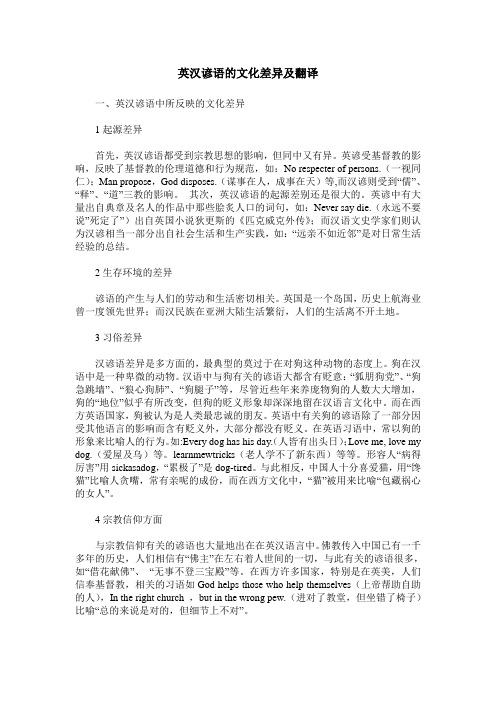
英汉谚语的文化差异及翻译一、英汉谚语中所反映的文化差异1起源差异首先,英汉谚语都受到宗教思想的影响,但同中又有异。
英谚受基督教的影响,反映了基督教的伦理道德和行为规范,如:No respecter of persons.(一视同仁);Man propose,God disposes.(谋事在人,成事在天)等,而汉谚则受到“儒”、“释”、“道”三教的影响。
其次,英汉谚语的起源差别还是很大的。
英谚中有大量出自典章及名人的作品中那些脍炙人口的词句,如:Never say die.(永远不要说”死定了”)出自英国小说狄更斯的《匹克威克外传》;而汉语文史学家们则认为汉谚相当一部分出自社会生活和生产实践,如:“远亲不如近邻”是对日常生活经验的总结。
2生存环境的差异谚语的产生与人们的劳动和生活密切相关。
英国是一个岛国,历史上航海业曾一度领先世界;而汉民族在亚洲大陆生活繁衍,人们的生活离不开土地。
3习俗差异汉谚语差异是多方面的,最典型的莫过于在对狗这种动物的态度上。
狗在汉语中是一种卑微的动物。
汉语中与狗有关的谚语大都含有贬意:“狐朋狗党”、“狗急跳墙”、“狼心狗肺”、“狗腿子”等,尽管近些年来养庞物狗的人数大大增加,狗的“地位”似乎有所改变,但狗的贬义形象却深深地留在汉语言文化中。
而在西方英语国家,狗被认为是人类最忠诚的朋友。
英语中有关狗的谚语除了一部分因受其他语言的影响而含有贬义外,大部分都没有贬义。
在英语习语中,常以狗的形象来比喻人的行为。
如:Every dog has his day.(人皆有出头日);Love me, love my dog.(爱屋及乌)等。
learnmewtricks(老人学不了新东西)等等。
形容人“病得厉害”用sickasadog,“累极了”是dog-tired。
与此相反,中国人十分喜爱猫,用“馋猫”比喻人贪嘴,常有亲呢的成份,而在西方文化中,“猫”被用来比喻“包藏祸心的女人”。
4宗教信仰方面与宗教信仰有关的谚语也大量地出在在英汉语言中。
英汉语谚语文化差异的比较研究

英汉语谚语文化差异的比较研究英汉语言中有很多谚语,它们是人们长期生活实践中总结出来的形象化、含义深刻的话语,体现了一种语言文化的智慧和传承。
然而,由于英汉语言和文化的差异,英汉谚语存在着一些文化差异。
首先,英汉谚语在表达方式上有所不同。
比如,“骑虎难下”是一句中国常用的谚语,意为难以回头或难以扭转,在此谚语中,大量使用了比喻手法,通过比喻虎的性格来形容困境。
而在英国,“a bird in the hand is worth two in the bush”是一句常见的谚语,意为手中一只鸟胜过树上两只鸟,这种表达方式更加直接和简洁,在信息传递上更直接。
其次,英汉谚语在所表现的文化内涵上存在不同。
比如,“萝卜白菜,各有所爱”是一句中文谚语,以食物为隐喻,强调个人喜好的不同;而在英语中则有“different strokes for different folks”的谚语,意思和萝卜白菜类似,但更加注重个人的差异和多元性。
这说明中国的谚语更加注重集体文化的思想,而英国的谚语则更注重个体多样性。
再者,英汉谚语还存在着文化背景与历史传承的差异。
比如,“海阔凭鱼跃,天高任鸟飞”是一句中国传统的谚语,充分表达了人们坚韧不拔的精神和进取的态度。
而在英国,有“when in Rome, do as the Romans do”的谚语,意思是入乡随俗,尊重当地的文化习俗,避免冲突。
这种谚语来自于罗马帝国时期的当地风俗和文化,旨在帮助外来者适应当地环境和习俗。
总之,英汉谚语虽然在很多方面存在着不同,但它们都代表了各自文化的智慧和传承。
跨文化的交流和理解,需要深入了解和尊重对方的文化背景和价值观念,才能更加成功地进行沟通和交流。
英汉谚语的文化差异及英文谚语的汉译

一
作者简介 :王秀芬 ( 97 16 一 ),女,湖北成宁人,讲
师,在读硕 士,主要从事英语教学工作 。
4l一
维普资讯
王秀芬
英汉谚语 的文化差异及英文谚语 的汉译
过人参汤”、 “ 晚饭少吃一口。肚里舒服一宿”、 “ 狂饮
之处。
学学者爱得化 ・ 泰勒 (E w r B r tT l )于17年作 d a u e yr d nt o 81
出的权威定义:文化是一个复杂的整体 。它包括知识、信
本文仅以英汉文化的差异及英文谚语的汉译为例,作
引玉之谈。
2 英汉谚 语所体现 出的文化差异
英汉语谚语文化差异的比较研究

英汉语谚语文化差异的比较研究英汉语谚语是两种语言中常用的成语或短句,用来传达一种智慧或道理。
尽管英汉之间存在许多共同之处,但它们的文化差异也造就了各自独特的谚语。
本文将比较英汉语谚语的文化差异,并介绍几个例子来说明它们之间的不同。
英汉语谚语在表达方式上存在巨大差异。
汉语谚语通常更加直接和形象化,而英语谚语更倾向于使用比喻和隐喻。
中文谚语“一步一个脚印”意味着要踏实一点,努力逐步达到目标。
而英语谚语“Rome wasn't built in a day”(罗马不是一日建成的)传达了相同的意思,但使用了隐喻来强调事情需要时间来完成。
英汉语谚语的文化背景也有所不同。
英语谚语常常与英国历史、文学和宗教有关,反映了英国文化的价值观和传统。
英语谚语“Every cloud has a silver lining”(乌云后有阳光)源于英国天气多变的特点,表达了乐观与希望。
相比之下,汉语谚语更多地与中国历史、哲学和民俗有关。
中文谚语“修身齐家治国平天下”反映了儒家思想中关于个人修养、家庭和社会稳定的重要性。
英汉语谚语在内容上也存在不同。
英语谚语更倾向于强调个人独立和自主,鼓励人们自己追求幸福和成功。
英语谚语“God helps those who help themselves”(自助者天助)强调了个人的努力和自力更生。
相比之下,汉语谚语更强调集体和社会责任,鼓励人们为整个社会的利益而努力。
“人人为我,我为人人”反映了中国传统价值观中强调团队合作和互助的观念。
英汉语谚语在形式和语言结构上也有所不同。
英语谚语通常是使用句子形式,而中文谚语更偏向于短句形式。
这反映了英语更倾向于直接表达思想和理念,而汉语更注重简洁和意象的传达。
英汉语谚语之间存在许多文化差异。
英语谚语更倾向于比喻和隐喻的使用,强调个人自主和个人利益,而汉语谚语则更加直接和形象化,强调团队合作和社会责任。
这些差异反映了英汉两种语言背后不同的文化价值观和传统。
英汉谚语文化差异与翻译策略
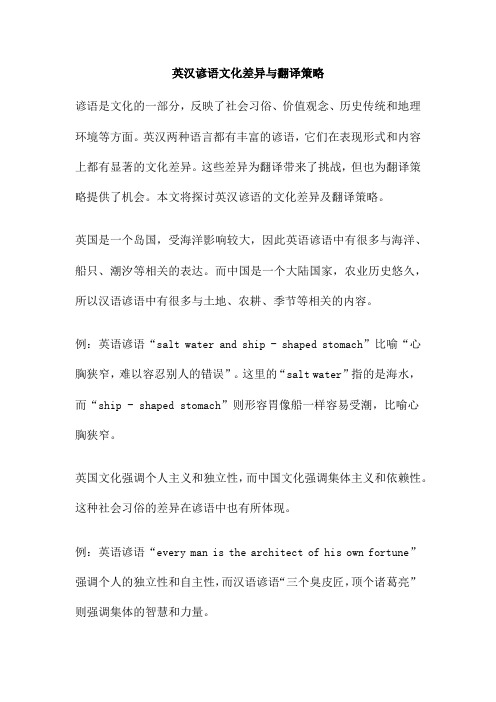
英汉谚语文化差异与翻译策略谚语是文化的一部分,反映了社会习俗、价值观念、历史传统和地理环境等方面。
英汉两种语言都有丰富的谚语,它们在表现形式和内容上都有显著的文化差异。
这些差异为翻译带来了挑战,但也为翻译策略提供了机会。
本文将探讨英汉谚语的文化差异及翻译策略。
英国是一个岛国,受海洋影响较大,因此英语谚语中有很多与海洋、船只、潮汐等相关的表达。
而中国是一个大陆国家,农业历史悠久,所以汉语谚语中有很多与土地、农耕、季节等相关的内容。
例:英语谚语“salt water and ship - shaped stomach”比喻“心胸狭窄,难以容忍别人的错误”。
这里的“salt water”指的是海水,而“ship - shaped stomach”则形容胃像船一样容易受潮,比喻心胸狭窄。
英国文化强调个人主义和独立性,而中国文化强调集体主义和依赖性。
这种社会习俗的差异在谚语中也有所体现。
例:英语谚语“every man is the architect of his own fortune”强调个人的独立性和自主性,而汉语谚语“三个臭皮匠,顶个诸葛亮”则强调集体的智慧和力量。
英国的历史文化悠久,许多英语谚语源自于历史事件、名人名言和经典文学作品。
而中国历史悠久,很多汉语谚语都包含有历史人物、传说故事等元素。
例:英语谚语“all’s well that ends well”源自于莎士比亚的喜剧《第十二夜》,意指“结局好就一切都好”。
而汉语谚语“姜太公钓鱼,愿者上钩”则源自于古代传说,意指“心甘情愿的事情不需要解释”。
直译法是指将原文的意思直接翻译成目标语言,保留原文的形式和风格。
在翻译英汉谚语时,可以采用直译法来保留原文的比喻、形象等元素。
例:英语谚语“time is money”可以直译为“时间就是金钱”,汉语谚语“瓜田李下”可以直译为“under the melon and plum trees”,比喻“避免给人产生误会的行为或环境”。
- 1、下载文档前请自行甄别文档内容的完整性,平台不提供额外的编辑、内容补充、找答案等附加服务。
- 2、"仅部分预览"的文档,不可在线预览部分如存在完整性等问题,可反馈申请退款(可完整预览的文档不适用该条件!)。
- 3、如文档侵犯您的权益,请联系客服反馈,我们会尽快为您处理(人工客服工作时间:9:00-18:30)。
一、引言 谚语翻译中最重要的因素是什么?英语语言及文学的著名学者王 佐良这样回答:文化差异,如这种文化中显而易见的东西在另一种文化 就要详细解释。因此译者需非常认真谨慎地处理文化差异。英国文化人 类学家Edward Taylor在《原始文化》一书中,首次把文化作为一个概念 提出来,并表述为:文化包括知识,信仰,艺术,道德,法律,风俗及其作 为社会上习得的能力与习惯。可见文化内涵丰富。谚语来源于生活,是 一个民族语言和文化的高度浓缩和集中体现。它反映了一个民族丰富 多彩的文化现象。它是语言词汇的重要组成部分,是语言某些部分,经过 长期反复使用后自然沉积而形成的形式固定,简洁明快,寓意深刻的语 言精品: 给谚语下一个固定的定义比较困难,因为不同的人对谚语理解不 同。如:谚语是在群众中流传的固定语句,用简单通俗的话反映出深刻 的道理:“Proverbs are the daughter of daily experience.”(谚语是日常生活 的产物);英国人类学家Tomas Fuller则认为:众多的事理经过煎熬,凝 练成寥寥数词,这便是谚语。总之,谚语作为民间文学形式的一种,具有 诗的活泼,文的凝重,熟练而简洁。 由于英汉两种语言的文化背景差异,同样字面意义,形象意义的话 可能具有完全不同的隐含意义。隐含意义才是说话人或作者所要表达 的真正意义。英汉谚语直接的多方面差异可归为两类:一是形象意义的 差异;一是隐含意义的差异,而它们都是字面以外的意义,即文化差异 的具体反映。 二、英汉谚语中的文化差异
浓,西域的直译就有了它的特殊重要性。”直译法更好地保留了英文中 原汁原味的成分,因此,如果读者能对译后的谚语寓言一目了然,我们
首先用直译法。例如: A home without love is no more than ababy without asoul.没有爱的家
庭就像一个没有灵魂的躯体。 He laughs best who laughs last.谁笑到最后谁笑得最好。 The eye is the window ofthe mind.眼睛是心灵的窗户。 Practice makefl perfect.熟能生巧o New-bern calves make tittle oftiger.初生牛犊不怕虎。 Time is money.时间就是金钱。 Life is short and time is swift.人生苦短,岁月易逝。 中文的谚语则有: 明枪易躲,暗箭难防。It is easy to dodge a spear in the open,but hard
科技信息
人文社科
督教,因此很多谚语源于《圣经》,或与基督教有关。如:theheartknows his own bitterness.一颗心知道它自己的痛苦。
Every mall must canT his own clogs.人人都要忍受生活中的苦难,承 担自己的生活负担。相关的还有:Nature dose nothing in vain.(造物主无 所不能);Cod helps those who help themselves.(上帝帮助自助的人)。In theright church,butinthewrongpew.(比喻总的来说是对的,但细节上不 对。)
(五)宗教信仰 宗教信仰是人们精神活动的一方面,对文化有一定的影响。与宗教 有关的谚语因而大量存在。佛教传人中国已有一千多年的历史,人们相 信有佛祖左右着人世间的一切,因此汉语中有许多含“佛”,“庙”等的谚 语,如“借花献佛”,“无事不登三宝殿”。反映道教思想的有:祸兮福所 倚,福兮祸所伏,乐极生悲。儒家思想在汉文化思想意识上也有重要地 位,留有谚语如:严于律己,宽以待人;恭敬不如从命;身在福中不知福; 天下兴亡匹夫有责;谁言寸草心,报得三春晖。在英语国家信奉的是基
渔业有关的英文谚语。如: Hook one’s fish用诡计得到想要的东西,如愿以偿 Have other fish to fry有其他鱼要煎,有其他事要做 Neveroffer to teach fish to swim.不要教鱼儿游泳,不要班门弄斧。
与英国不同,过去中国是一个农业大国,大部分人民都种田为生,
(三)历史背景 社会历史的发展对语言的影响巨大。谚语好像一面镜子,能清楚地 反映历史变迁。因此我们在翻译谚语时需考虑其历史背景,才能正确理 解谚语的涵义。公元前55年,古罗马统帅凯撒征服不列颠,英国历史上 真正的nol'mBn conquest是在公元43年开始的。从此罗马人占领不列 颠400年之久。罗马人的文化对不列颠的影响仍然存在,从今天的英 谚中可以发现历史的痕迹。
together.根据事实推断。Two of atrade nevel"agree同行是冤家。Between
two stools the breach cometh to the ground.同时坐两个凳子就会落空。而 在中文里,二含贬义,像:三心二意,三长两短。“三”在中英文中都象征 着好运,神圣。All gooa things go by three.一切好事以三为准;三生有幸 (consider oneselfmostfortunate);三六九等(various grades and ranks)o四
首先,最典型的是中英两国对狗和猫的态度差异。中国人比较鄙视 狗,汉语中与狗有关的词语大都含有贬义:狐朋狗友,狗急跳墙,狼心狗 肺,狗腿子,狗嘴里吐不出象牙,狗仗人势。尽管现在越来越多人把狗当 宠物,作者本人也很喜欢狗,但狗的贬义形象却仍留在汉语言文化中。 而英语国家大多对狗有好感,认为狗是忠实可靠的朋友。英语中,狗经 常用来比喻人的生活,派生出许多谚语。
Do in roman∞the roman do.人乡随俗。
Rome WaS not built in aday.罗马不是一天建成的。 All roads lead to rome.条条大道通罗马。比喻殊途同归。 Meetone’swaterloo.一败涂地。 中文中的历史谚语则有:朝秦暮楚,卧薪尝胆,图穷匕首见。许多中
靠天吃饭。因此农业和土地成为谚语的常见形象。比如:瑞雪兆丰年,枯 木逢春,斩草除根,挥金如土,过河拆桥,隔岸观火,拔苗助长。五谷丰 登,瓜熟蒂落,春华秋实,沧海桑田等。
(--)风俗习惯
风俗习惯是一国或一地区人民的生活方式,包括很多方面。英汉谚 语中很多都与习俗有关,其中的形象不管相同与否,涵义却差别很大。
三、翻译方法 翻译谚语时,仅仅寻求词汇间的对等是不够的。Nida指出:所有的 翻译,不管它是诗歌还是散文。都必须关心接受者的反应;因此翻译的 最终目的。从它对观众产生的效果而看,是评价任何翻译的最基本的因 素。关于翻译标准,中外翻译家们提出了各种主张,从严复的“信,达, 雅”。傅雷的“重神似不重形似”,张培基先生提出的“忠实通顺”到奈达 的功能对等或动态对等。这些主张侧重点不同,但中心都是译文要忠实 准确地表达原文的意义,保持原作的风格。在引言中作者提到,隐含意 义是原文意义中最重要的,译文应尽量准确表达隐含意义。谚语翻译绝 非易事,其方法一般分为以下几种: (一)直译法 所谓直译,指在译文语言条件许可时,在译文中既保持原文的内 容,又保持原文的形式——特别指保持原文的比喻,形象和地方色彩 等。张培基在《习语汉译英研究》中指出直译法的重要性,“由于一国语 言中的习语最能集中反映该国的民族文化,传统等特点,民族色彩很
科技信患
人文社科
英汉谚语文化差异及翻译方法
广西师范大学外国语学院 邓蓉
[摘要]谚语作为语言的结晶,包含丰富的文化内涵。由于中英两种文化存在诸多差异,导致谚语的翻译需考虑这些因素。本文先 分析英汉谚语的文化差异,然后针对这种翻译难现象总结了几种翻译方法。旨在强调作为译者对两种文化的精确把握至关重要。 [关键词】英汉谚语文化差异翻译方法
英谚语还是以历史人物为形象。Every Caesar has his Brutus;damon and Pythias;Lazarus and Dives.汉语的有:班门弄斧,半路上杀出一个程咬 金,三个臭皮匠,顶个诸葛亮,东施效颦,名落孙山,叶公好龙。
(四)文学典故
来自古希腊罗马神话寓言的谚语有:Troj∞horse;the apple ofdis"- cord;8pyrrhic victory;pandora’S box(潘多拉之盒,灾难,麻烦,祸害的根 源)。Achilles’8 heel(唯一致命弱点)。来自《伊索寓言》的有:adoginthe manger(狗占马槽,占着茅坑不拉屎)。中国的则有:孙悟空七十二变,精 卫填海,牛郎织女。由莎士比亚等文学大师的作品中来:Brevity is the soul ofwit.Never say die(永远不要说死定了)出自狄更斯的《匹克威克外 传》。
每种语言都有深厚的文化内涵,与其地理环境,习俗,宗教,历史等 密切相关。作为语言表达特殊形式的英汉谚语,与各自文化密切相关, 传达了不同的语言特点和本国信息,反映了丰富的文化内涵。作者认为 英汉谚语的差异主要体现在以下几方面:
(一)地理环境
地理环境指人类社会的生存环境,极大影响一国文化的形成。改 变。对各国语言的特点也起决定性作用。谚语的产生与人们生产生活的 环境密切相关。中英两国地理环境显著不同,在谚语中就得到体现。英 国是一个四面环海的岛国,英吉利海峡是欧洲许多国家通向大西洋的 唯一出口,也是世界上最繁忙的海上要道之一。因此英国历史上航海业
曾一度在世界领先,导致英语中有许多与航海有关的谚语,如下: A small leak will sink agreat ship.千里之堤,毁于蚁穴 To keep one’s head above water奋力图存 To take the wind out ofone’8 sail先发制人,抢占先风 To go with the steaH卉ide随波逐流,顺应时势 英国独特的地理环境使捕鱼业在经济中非常重要,留下了大量与
在汉语里意味着稳定统一。四海之内皆兄弟(all men are brothers);四海 为家(make one’shomewhereveroneis);“六”是非常特别的数字,包含安
